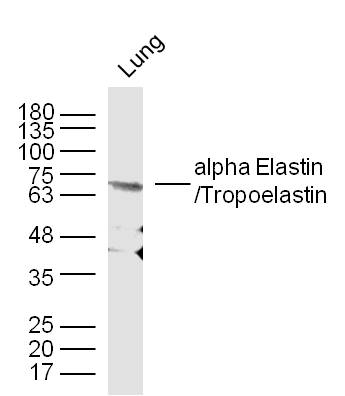
IHC-Fr analysis of mouse skin tissue using GTX37428 Elastin antibody. Dilution : 1:100
Elastin antibody
GTX37428
ApplicationsWestern Blot, ImmunoHistoChemistry, ImmunoHistoChemistry Frozen, ImmunoHistoChemistry Paraffin
Product group Antibodies
ReactivityHuman, Mouse, Rat
TargetELN
Overview
- SupplierGeneTex
- Product NameElastin antibody
- Delivery Days Customer9
- Application Supplier NoteIHC-P: 1:100-500. *Optimal dilutions/concentrations should be determined by the researcher.Not tested in other applications.
- ApplicationsWestern Blot, ImmunoHistoChemistry, ImmunoHistoChemistry Frozen, ImmunoHistoChemistry Paraffin
- CertificationResearch Use Only
- ClonalityPolyclonal
- Concentration0.5 mg/ml
- ConjugateUnconjugated
- Gene ID2006
- Target nameELN
- Target descriptionelastin
- Target synonymsADCL1, SVAS, WBS, WS, elastin, tropoelastin
- HostRabbit
- IsotypeIgG
- Protein IDP15502
- Protein NameElastin
- Scientific DescriptionThis gene encodes a protein that is one of the two components of elastic fibers. Elastic fibers comprise part of the extracellular matrix and confer elasticity to organs and tissues including the heart, skin, lungs, ligaments, and blood vessels. The encoded protein is rich in hydrophobic amino acids such as glycine and proline, which form mobile hydrophobic regions bounded by crosslinks between lysine residues. Degradation products of the encoded protein, known as elastin-derived peptides or elastokines, bind the elastin receptor complex and other receptors and stimulate migration and proliferation of monocytes and skin fibroblasts. Elastokines can also contribute to cancer progression. Deletions and mutations in this gene are associated with supravalvular aortic stenosis (SVAS) and autosomal dominant cutis laxa. [provided by RefSeq, Aug 2017]
- ReactivityHuman, Mouse, Rat
- Storage Instruction-20°C or -80°C,2°C to 8°C
- UNSPSC12352203
References
- Lee TH, Yeh CF, Lee YT, et al. Fibroblast-enriched endoplasmic reticulum protein TXNDC5 promotes pulmonary fibrosis by augmenting TGFβ signaling through TGFBR1 stabilization. Nat Commun. 2020,11(1):4254. doi: 10.1038/s41467-020-18047-xRead this paper
- Hönig J, Mižíková I, Nardiello C, et al. Transmission of microRNA antimiRs to mouse offspring via the maternal-placental-fetal unit. RNA. 2018,24(6):865-879. doi: 10.1261/rna.063206.117Read this paper
- Shih YC, Chen CL, Zhang Y, et al. Endoplasmic Reticulum Protein TXNDC5 Augments Myocardial Fibrosis by Facilitating Extracellular Matrix Protein Folding and Redox-Sensitive Cardiac Fibroblast Activation. Circ Res. 2018,122(8):1052-1068. doi: 10.1161/CIRCRESAHA.117.312130Read this paper









![IHC-P analysis of human small intestine tissue section using GTX02630 Elastin antibody [ELN/3131R].](https://www.genetex.com/upload/website/prouct_img/normal/GTX02630/GTX02630_20210319_IHC-P_1_w_23053122_561.webp)

![IHC-P analysis of human small intestine tissue using GTX17734 Elastin antibody [ELN/1981].](https://www.genetex.com/upload/website/prouct_img/normal/GTX17734/GTX17734_20200115_IHC-P_1149_w_23060620_895.webp)